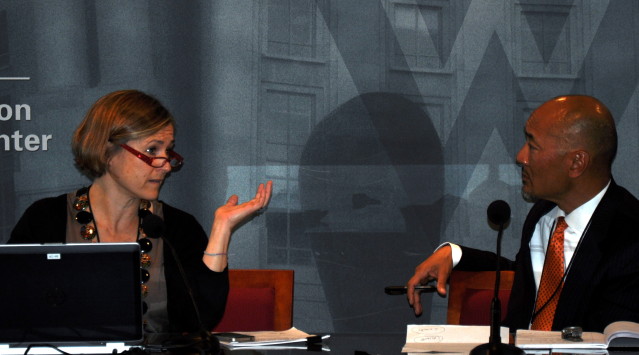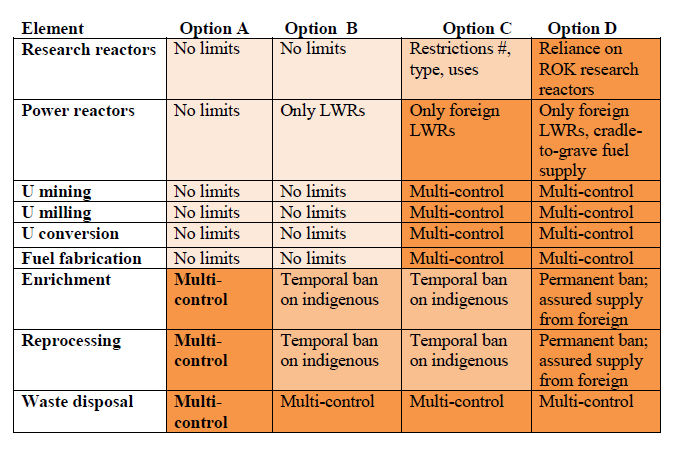by Sharon Squassoni
April 9, 2013
This report was originally presented at the New Approach to Security in Northeast Asia: Breaking the Gridlock workshop held on October 9th and 10th, 2012 in Washington, DC.
I. Introduction
This memorandum explores the contours of nuclear energy in the DPRK as part of a comprehensive peace settlement. It assumes: a) DPRK must rejoin NPT as a non-nuclear weapon state and must ratify the Additional Protocol; b) DPRK is likely to press for the right to nuclear power in any settlement; c) limitations may not be equally applied across all non-nuclear-weapon states (vice Halperin paper); and d) there are no guarantees against proliferation, even in a unified Korea.
The views expressed in this report do not necessarily reflect the official policy or position of the Nautilus Institute. Readers should note that Nautilus seeks a diversity of views and opinions on significant topics in order to identify common ground.
Sharon Squassoni is a Senior Fellow & Director of the Proliferation Prevention Program at the Center for Strategic & International Studies.
II. Policy Forum by Sharon Squassoni
DPRK Nuclear Energy in the Context of a Proposed Peace Settlement
This memorandum explores the contours of nuclear energy in the DPRK as part of a comprehensive peace settlement. It assumes: a) DPRK must rejoin NPT as a non-nuclear weapon state and must ratify the Additional Protocol; b) DPRK is likely to press for the right to nuclear power in any settlement; c) limitations may not be equally applied across all non-nuclear-weapon states (vice Halperin paper); and d) there are no guarantees against proliferation, even in a unified Korea. The outcome must minimize future proliferation risks and avoid damaging the nonproliferation regime at large (e.g., letting DPRK “keep” sensitive nuclear facilities). There is ample room for a Korean agreement to set the bar higher than the NPT does, both in terms of assistance and restrictions.
Nuclear capabilities negotiated under a settlement must contribute to building and maintaining confidence that the DPRK is using nuclear energy for peaceful purposes. This should guide the degree of flexibility accorded to the DPRK, particularly for indigenous capabilities. Flexibility could increase over time, but should start small.
That said, there will be pressure to demonstrate the tangible benefits of the DPRK’s “coming in from the cold.” North Koreans may argue for a South African model (state giving up nuclear weapons with no subsequent restrictions) but this should be dismissed because South Africa’s weapons program pre-dated its adherence to the NPT. A state that has violated the NPT needs to set new standards. It is equally important to dismiss the precedent of Iran (a state violating the NPT that keeps its sensitive nuclear technology, so far) because Iran has not crossed the nuclear testing threshold (an unambiguous demonstration of nuclear weapons capability) and has not pulled out of the NPT.
Negotiators must acknowledge that there is no consensus within the nuclear nonproliferation community about how to minimize proliferation risks of fuel cycle capabilities, nor even in official U.S. government circles. In particular, U.S. acquiescence to ROK enrichment and pyroprocessing could play against efforts to limit the DPRK. A Korean peninsula that contains enrichment and reprocessing in both North and South would pose an unacceptable proliferation risk.
The starting point is agreement on the principle that North Korea must demonstrate a lower proliferation risk than in the past. This can be accomplished through restrictions on capabilities (indigenous vs. foreign, some technologies versus others), allowing additional access and/or monitoring to the IAEA, or even setting up multinational monitoring teams under a NWFZ.
Nuclear Energy Contours
Nuclear energy has medical, agricultural, research, industrial, and power generation uses, encompassing research reactors, power reactors, possibly fuel cycle capabilities (uranium mining, milling, conversion, fuel fabrication, enrichment, reprocessing) and nuclear waste disposal. Of these, the most sensitive are enrichment and reprocessing, which pose significant risks for proliferation. Negotiators should stress other sources of electricity generation as most beneficial for energy security, with nuclear energy as a “nice to have.” Assistance should be generous in nuclear security, nuclear safety and safeguards; efforts in training should be carried out on the ground in the DPRK rather than abroad. As time goes on, more areas of collaboration should open up to DPRK scientists through the IAEA’s technical cooperation program but at the start, it could be limited to assistance from the negotiating parties.
Options
Working from minimal to maximal restrictions, options are outlined below:
- 1. Option A (assuming Joint Declaration is rendered moot): No limits on numbers or types of power reactors (LWRs or heavy water) or DPRK indigenous supply; no limits on research reactors; front-end fuel cycle unlimited up to enrichment (uranium mining, milling conversion, fuel fabrication); enrichment, reprocessing and nuclear waste disposal under strict multinational ownership/control.
- 2. Option B: Power reactors limited to LWRs (no research on fast reactors, no PHWRs); No limits on research reactors; front-end fuel cycle up to enrichment unlimited; ban (temporal) on enrichment and reprocessing; nuclear waste disposal under strict multinational ownership and control.
- 3. Option C: Option B + restrictions on research reactors + PWRs limited to foreign-built + front-end fuel cycle up to enrichment under strict multinational ownership and control.
- 4. Option D: Option C + reliance on ROK research reactors in lieu of DPRK research reactors; permanent ban on enrichment and reprocessing, but built-in fuel assurances and/or cradle-to-grave fuel supply.
Influential factors
Although the Halperin approach assumes destruction of production facilities, this seems to conflict with his admonition that any limits on the DPRK would have to be applied to other non-nuclear weapon states (production facilities include enrichment and reprocessing in addition to Pu production reactors). Option A would require any remnants of enrichment or reprocessing to be carefully monitored, while Option B would call for a temporary ban (and thus destruction or denaturing) and Options C and D would call for a permanent ban. Negotiators should think in terms of playing off assistance for restrictions (See Annex A), and encourage a range of assistance in training, equipment, evaluations for safety, security and safeguards, co-ownership, assured fuel supply or even fuel cycle collaboration. In terms of fuel cycle capabilities, the Northeast Asian NWFZ could offer an opportunity to redefine what’s risky in a NWFZ and that could include national ownership of fuel cycle facilities. One possibility is transitioning to multinational ownership of Japanese enrichment and reprocessing and expanding it to service the region; another possibility would disperse fuel cycle capabilities across Japan, ROK and DPRK.
Annex A: Mapping Limitations on and Assistance to DPRK Nuclear Energy
The darker the shade, the more likely assistance will be required.
ANNEX B: Lessons of other Nuclear Weapon Free Zones (NWFZ) Regarding Peaceful Uses of Nuclear Energy for the DPRK
The first NWFZ was the Treatly of Tlatelolco (1967), which included Article 17: Use of nuclear energy for peaceful purposes
Nothing in the provisions of this Treaty shall prejudice the rights of the Contracting Parties, in conformity with this Treaty, to use nuclear energy for peaceful purposes, in particular for their economic development and social progress.
This language formed the basis for Article IV in the NPT, which read slightly differently:
- 1. Nothing in this Treaty shall be interpreted as affecting the inalienable right of all the Parties to the Treaty to develop research, production and use of nuclear energy for peaceful purposes without discrimination and in conformity with Articles I and II of this Treaty.
- 2. All the Parties to the Treaty undertake to facilitate, and have the right to participate in, the fullest possible exchange of equipment, materials and scientific and technological information for the peaceful uses of nuclear energy. Parties to the Treaty in a position to do so shall also co-operate in contributing alone or together with other States or international organizations to the further development of the applications of nuclear energy for peaceful purposes, especially in the territories of non-nuclear-weapon States Party to the Treaty, with due consideration for the needs of the developing areas of the world.
The South African NWFZ, or the Treaty of Pelindaba, included Article 8 on Peaceful Nuclear Activities:
- 1. Nothing in this Treaty shall be interpreted as to prevent the use of nuclear science and technology for peaceful purposes.
- 2. As part of their efforts to strengthen their security, stability and development, the Parties undertake to promote individually and collectively the use of nuclear science and technology for economic and social development. To this end they undertake to establish and strengthen mechanisms for cooperation at the bilateral, subregional and regional levels.
- 3. Parties are encouraged to make use of the program of assistance available in IAEA and, in this connection, to strengthen cooperation under the African Regional Cooperation Agreement for Research, Training and Development Related to Nuclear Science and Technology (hereinafter referred to as AFRA).
The Treaty of Bangkok (SEANWFZ) included a rather lengthy article on the peaceful uses of nuclear energy, as follows:
Article 4 USE OF NUCLEAR ENERGY FOR PEACEFUL PURPOSES
- 1. Nothing in this Treaty shall prejudice the right of the States Parties to use nuclear energy, in particular for their economic development and social progress.
- 2. Each State Party therefore undertakes:
- (a) to use exclusively for peaceful purposes nuclear material and facilities which are within its territory and areas under its jurisdiction and control;
- (b) prior to embarking on its peaceful nuclear energy program, to subject its program to rigorous nuclear safety assessment conforming to guidelines and standards recommended by the IAEA for the protection of health and minimization of danger to life and property in accordance with Paragraph 6 of Article III of the Statute of the IAEA;
- (c) upon request, to make available to another State Party the assessment except information relating to personal data, information protected by intellectual property rights or by industrial or commercial confidentiality, and information relating to national security;
- (d) to support the continued effectiveness of the international non-proliferation system based on the Treaty on the Non-Proliferation of Nuclear Weapons (NPT) and the IAEA safeguards system; and
- (e) to dispose radioactive wastes and other radioactive material in accordance with IAEA standards and procedures on land within its territory or on land within the territory of another State which has consented to such disposal.
- 3. Each State Party further undertakes not to provide source or special fissionable material, or equipment or material especially designed or prepared for the processing, use or production of special fissionable material to:
- (a) any non-nuclear-weapon State except under conditions subject to the safeguards required by Paragraph l of Article III of the NPT; or
- (b) any nuclear-weapon State except in conformity with applicable safeguards agreements with the IAEA.
Lastly, the Central Asian NWFZ simply stated in Article 7 that “No provision of this Treaty shall prejudice the rights of the Parties to use nuclear energy for peaceful purposes.” The South Pacific NWFZ (Rarotonga) avoided the issue by referring to safeguards in its article on peaceful uses of nuclear energy.
Analysis:
The nuclear weapon free zones certainly did not want to place limits on the peaceful uses of nuclear weapons. Some of the language is vague, but the later treaties are more specific (e.g., Bangkok). Some of those provisions – insistence on safety assessments, provision of information, etc. – could be useful in the context of a Northeast Asian NWFZ. The NEANWFZ could go further and create real and binding obligations regarding nuclear waste, which would be a boon to the global nuclear energy community.
S. Squassoni
CSIS
September 27, 2012
III. NAUTILUS INVITES YOUR RESPONSES
The Nautilus Peace and Security Network invites your responses to this report. Please leave a comment below or send your response to: nautilus@nautilus.org. Comments will only be posted if they include the author’s name and affiliation.



